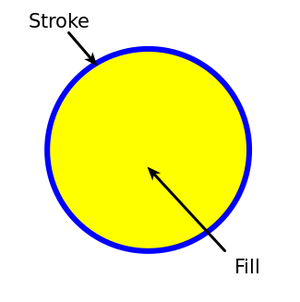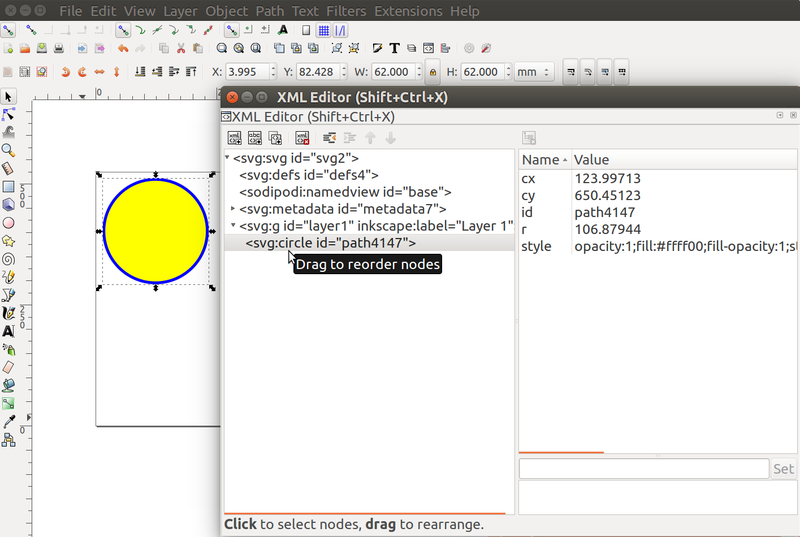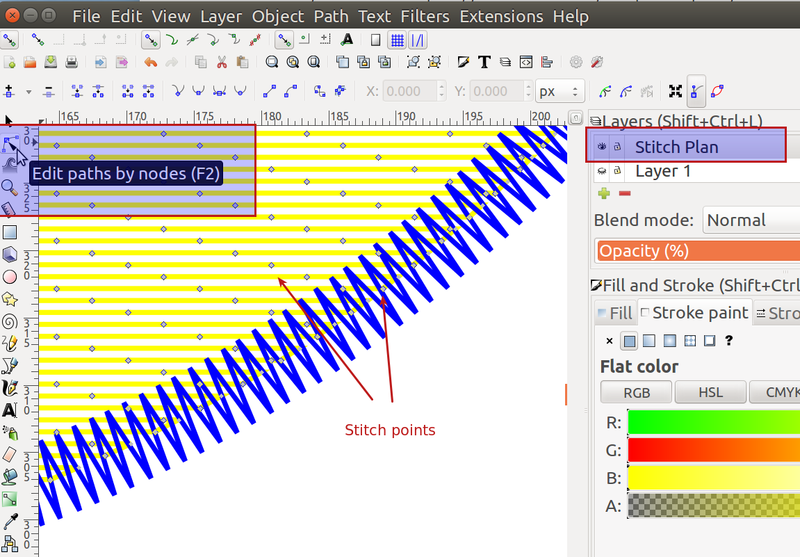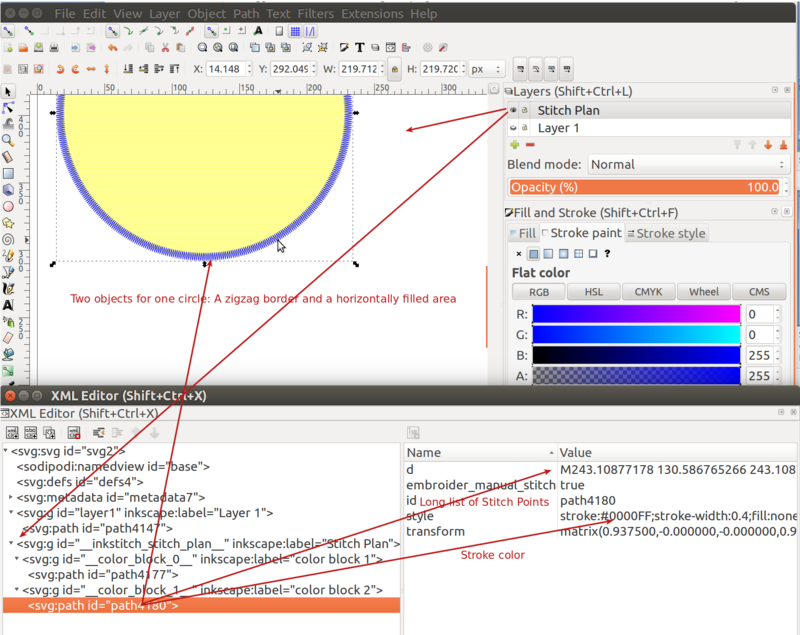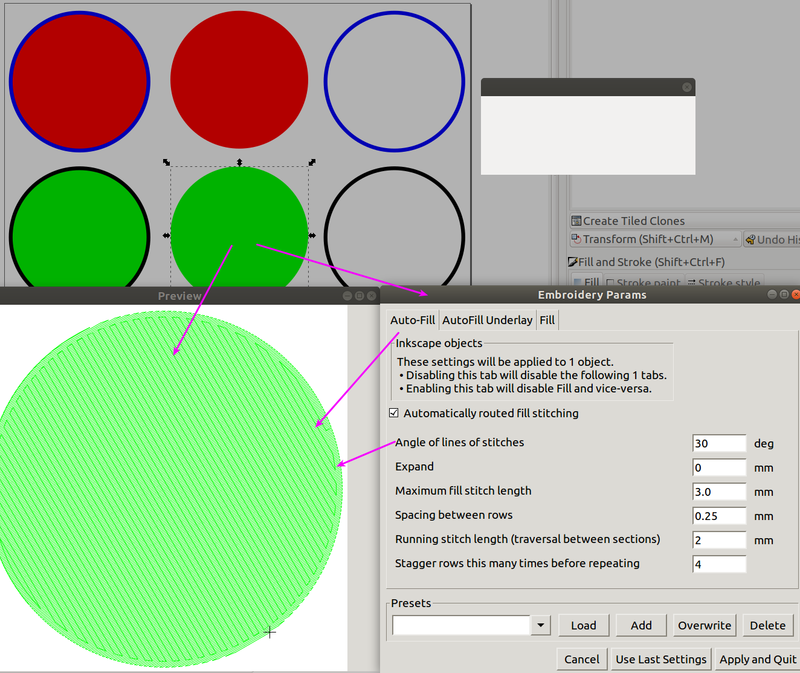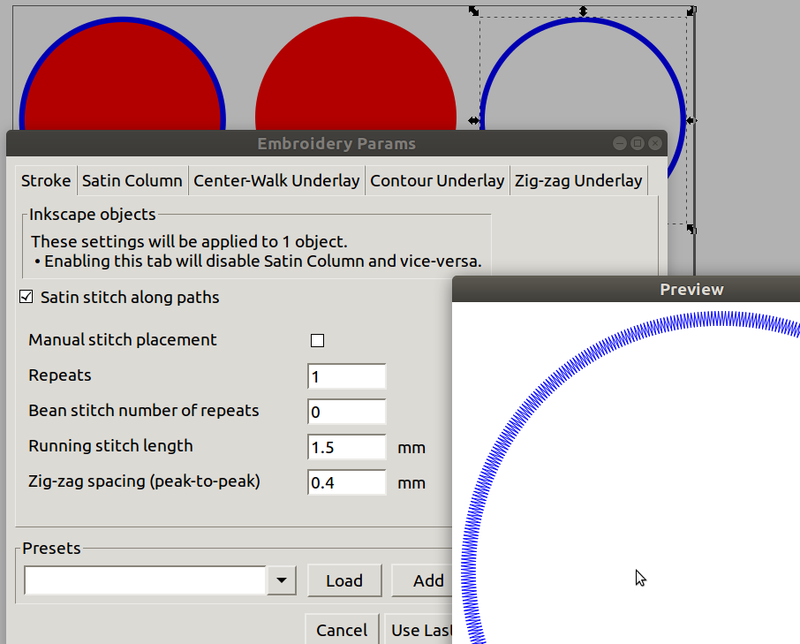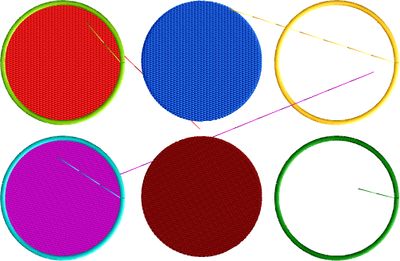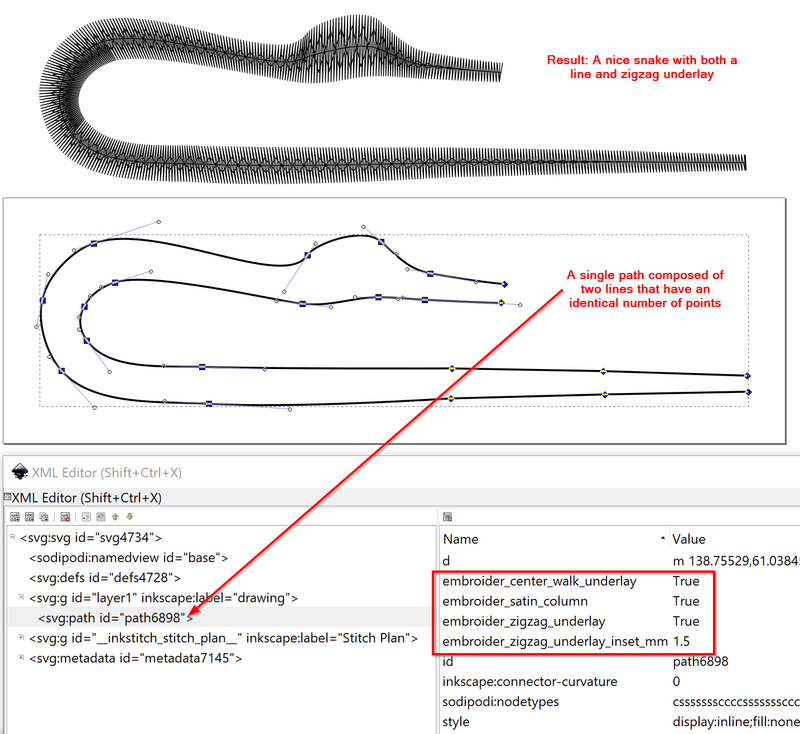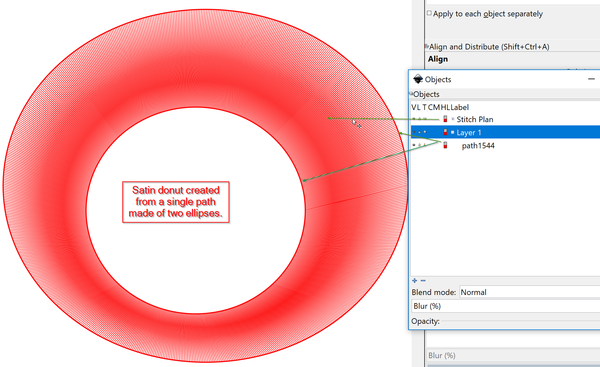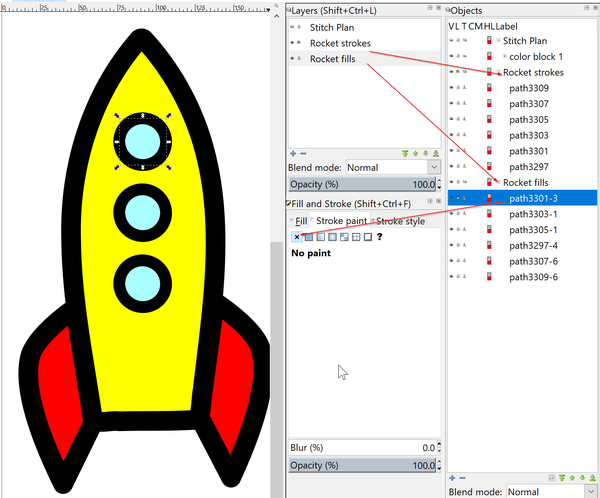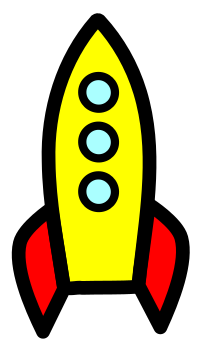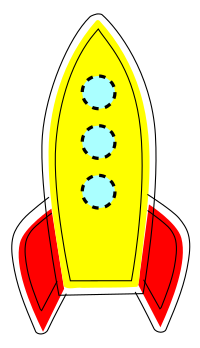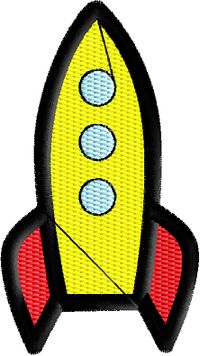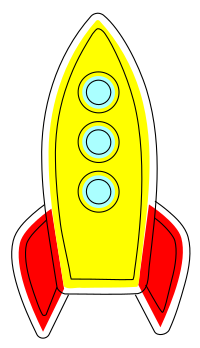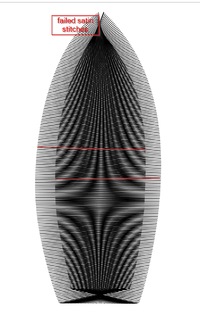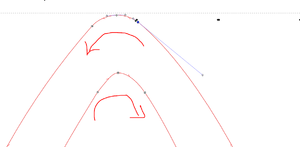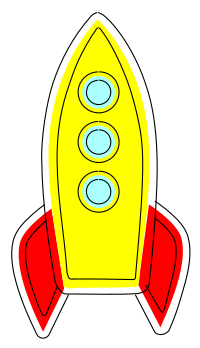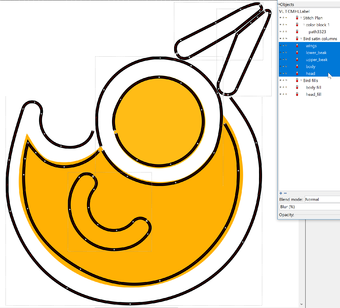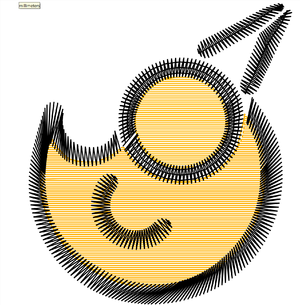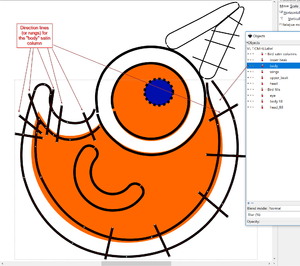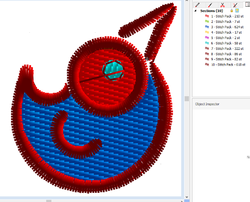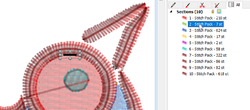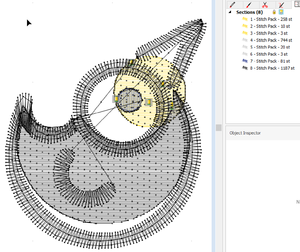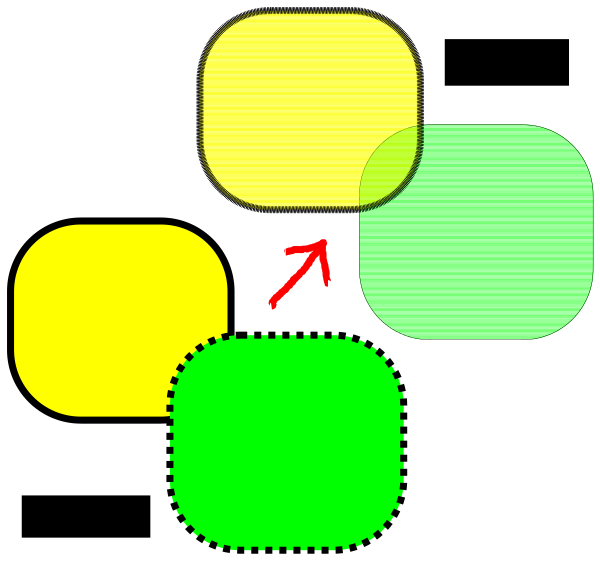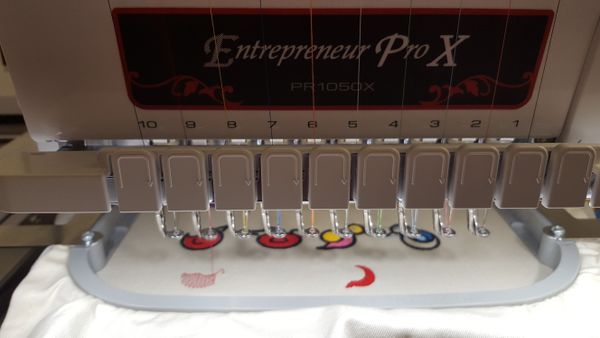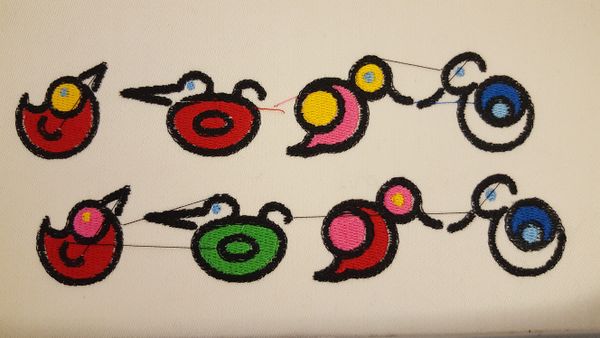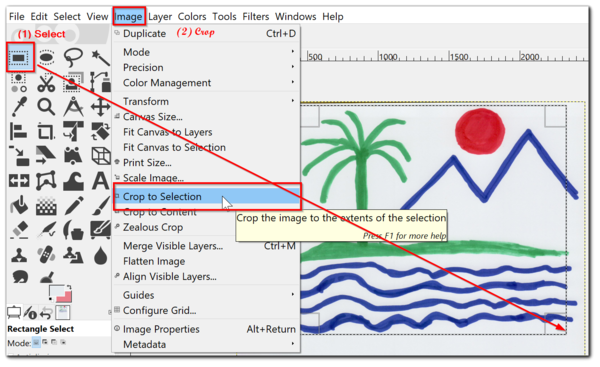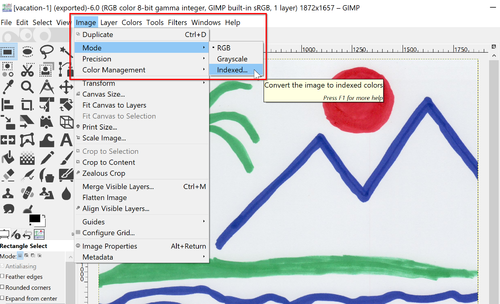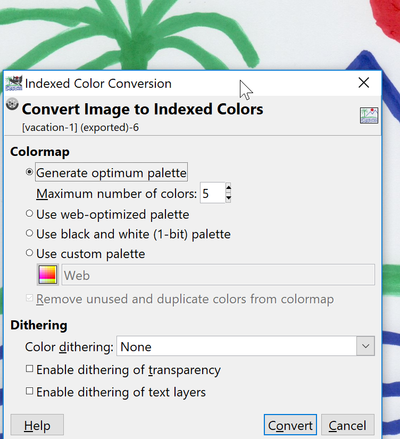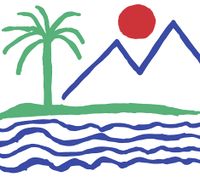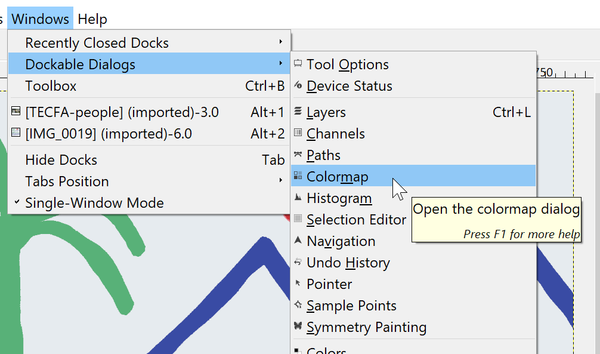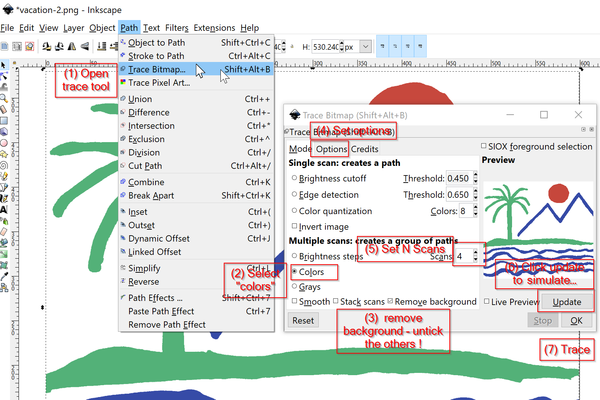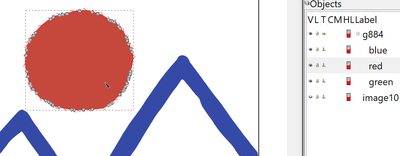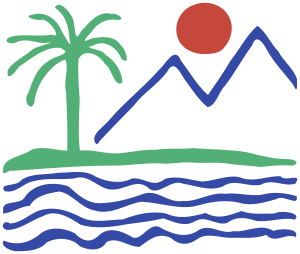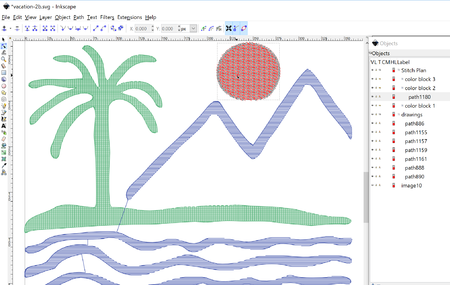InkStitch: Difference between revisions
| Line 762: | Line 762: | ||
Normally, for embroidery, use agressive smoothing options (however, this doesn't have an interesting effect in our case.): | Normally, for embroidery, use agressive smoothing options (however, this doesn't have an interesting effect in our case.): | ||
[[file:inkscape-tracing-2.png| | [[file:inkscape-tracing-2.png|400px|none|thumb|Tracing with Inkscape - Extra tracing options]] | ||
After tracing, the picture is still there, you can consider killing or leaving it as hidden layer. Now check the result | After tracing, the picture is still there, you can consider killing or leaving it as hidden layer. Now check the result | ||
Revision as of 21:23, 4 June 2018
Introduction
Ink/Stitch is an Inkscape extension for designing machine embroidery patterns and machine embroidery files. According to the extension page, “Select objects that you want to apply embroidery properties and using the extension, set the parameters for the desired object(s). Once all desired objects have embroidery properties, use the extension to generate the necessary stitch file.”
Warning and disclaimer: This page is not associated with the InkStitch project. Please also read the documentation (including tutorials) in the official site. We just made a little tutorial while we were learning and testing this extension.
As far as we can tell without much testing (May 3 2018, InkStich version 1.7) this extension seems to be the first usable open source program that allows creating embroidery files within an open source drawing tool. Summarizing:
- Ink/Stitch allows creating stitch files from particular SVG drawings, i.e. so-called path. Any SVG object can be translated into a path object.
- SVG fills can translate to filled stitch areas, SVG strokes can translate to zigzag (simple satin) and lines. Finally, there is a mechanism to create satin columns from path that include two sub-path lines.
- SVG path objects can be parameterized for all of these four stitch types (filled areas, simple zigzags, complex satin zigzags, or lines). Various underlays can be configured, e.g. satin stitches can have three sorts (a center line, border lines or a zigzag).
- InkStitch also supports thread color and project management.
As of May 30, 2018 the latest release was 1.8.1 We did most of the testing with version 1.7. We strongly encourage using the latest version and checking regularly for updates. E.g. PES users (Brother machines) must upgrade from 1.8.0 to 1.8.1 (or later). InkStitch is a live project.
See also:
- Computerized embroidery
- Embroidery glossary and Concepts of computerized embroidery
- Computerized embroidery in education
Installation
This extension software was tested with Ubuntu 16x and Windows 10 on May 3 2018. We managed to produce embroidery files for both Linux and Windows.
First time installation
- Download the latest release
- De-archive in the personal extension folder of Inkscape.
Under Ubuntu
- Extract files to
~/.config/inkscape/extensions
cd ~/.config/inkscape/extensions tar zxf ~/Downloads/inkstitch-v1.0.0-Linux-x86_64.tar.gz
Under Win 10
- Unhide the AppData directory (go to c:\users\__your_home__\, e.g. c:\users\janet
- Unzip in c:\users\__you__\AppData\Roaming\inkscape\extensions
If this does not work, check where the extension folder is in Inkscape: Edit->Preferences->System
Once you installed the extension, restart Inkscape.
Upgrades
You may have to delete the old extension files first. The download page will you so. Go to the extension directory and kill each embroidery* and inkstitch* file.
Then, proceed as above.
Basic use of InkStitch
You can try to following steps in order to test the extension and to learn about basic functionality.
Step 1 - draw an object
Create an object, e.g. a circle. You can use both fill and stroke. Below is an example and its SVG code.
The SVG code defining the object uses the SVG circle tag.
<circle
style="opacity:1;fill:#ffff00;fill-opacity:1;stroke:#0000ff;stroke-width:5.92615652;stroke-miterlimit:4;stroke-dasharray:none;stroke-opacity:1"
id="path4147"
cx="123.99713"
cy="650.45123"
r="106.87944" />
You can open the builtin XML tree editor if you want to check the code (CTRL-SHIFT-X)
Step 2 - convert to path
Transform all objects you want to stitch to paths:
- Select all object(s), e.g. hit CTRL+A
- Menu Path->Object to Path
An SVG Path includes both numbers representing positions and letters representing drawing and moving operations, including Bezier curves and Arcs. You do not need to understand how this works. Only make sure that all objects you plan to stitch are represented by a path. To check this, open the XML editor, then click on the object in the workspace. The XML code will be highlighted.
<path
style="opacity:1;fill:#ffff00;fill-opacity:1;stroke:#0000ff;stroke-width:5.92615652;stroke-miterlimit:4;stroke-dasharray:none;stroke-opacity:1"
d="M 230.87657,650.45123 A 106.87944,106.87944 0 0 1 123.99713,757.33067 106.87944,106.87944 0 0 1 17.117691,650.45123 106.87944,106.87944 0 0 1 123.99713,543.57179 106.87944,106.87944 0 0 1 230.87657,650.45123 Z"
id="path4147" />
Objects that are not of "Path" type, are ignored by InkStitch (remember that!)
Step 3 - Parametrize SVG path for embroidery
Select at leas one object. In menu Extensions -> Embroider -> Select Params and play with them. There are actually quite a lot compared to other SVG to embroidery translators.
For now, we just suggest accepting the defaults. We shall explain more parametrization in the next section. You also will learn later that InkStitch will add properties to SVG paths, defining how stitch objects should be created from each drawing.
Step 4 - Create the Embroidery file
You can either create a stitch file for a selection of objects or for all path objects. To create an embroidery file for the whole design:
- Click into some empty space (in order to deselect)
- Menu Extensions -> Embroider -> Embroidery
- Select the format of your machine. In case you are unhappy with the result, select a widely used format such as Tajima (DST) and then use a free translator to convert to your proprietary format.
- Type a directory name where you can find your files, e.g. c:\users\__you__\Desktop on windows or /home/schneide/schneide/embroidery/inkstitch under Linux. The file will remember this information.
You can skip the next step providing some technical details about how embroidery objects are represented in Inkscape.
Step 5 - Inspect in Inkscape
You now also will have a new layer that includes the Stitch Plan, i.e. the objects that have been exported as Stitch objects. You can check this to visualize the points that will be stitched. Alternatively you could use an embroidery viewer
In order to examine the Stitch points
- select the Stitch Plan layer and hide the others (this should be done automatically after using the Embroidery operation).
- Select the Edit Path tool in Inkscape
- Zoom in
If you look at the SVG code, you can see that your path are now annotated with stitching information. In addition, the new stitch plan layer contains two huge path objects - one for the border and one for the fill - that define all the points to be stitched, plus the stroke color for both. Since the circle was split into two objects with strokes, there is of course no more fill.
Simple embroidery parametrization of SVG objects
InkStitch can produce four kinds of stitch packs from an SVG object: Running stitches, simple zigzag, satin columns and fill stitches.
- A filled stitch area from SVG path with
filldefined - Simple zigzag or running stitches (lines) from SVG objects with
strokedefined - Two objects (an area and a zigzag/line) from a path that has both fill and stroke
- Satin stitches from a path that includes two "polyline" subpaths
If we understood right:
- SVG Fills can only translate to areas (also called tatami stitches or fills)
- Strokes translate to simple zigzag or simple lines
- Two strokes with the same amount of nodes can translate to satin columns
Paths with fills to embroidery areas
SVG fills are translated to areas filled with a simple linear pattern. You can define an underlay, density and orientation (rotation), and add trim and stop code, i.e. have the machine cut the thread and/or stop.
In order to parametrize a fill:
- Select an path object that has a fill and no stroke (e.g. something like the green or the red circle below)
- Open the parameter popup window: Menu Extensions -> Embroidery -> Params
You will see a little popup that say "Params working, please wait". Just move it out of the way and ignore it. Now look at the Embroidery Params popup window. It will have three tabs (see grey popup in the next screen capture).
- Auto-Fill: Try to change the fill angle. You can also can add STOP and Trim code if they are supported by the stitch file.
- AutoFill Underlay: Add an underlay, i.e. stitches that will be stitched underneath the pattern. This will add some stability and also a little 3D effect. Do not make it too dense.
- Fill: An alternative to auto fill
Paths with strokes to zigzag stitches
SVG strokes are translated to simple zigzag or satin stitches that can have an underlay. If you open again the Param popup (Menu Extensions -> Embroidery -> Params), you will see different tabs:
- Stroke (used by default)
- Satin Column
- Center-Walk Underlay
- Contour Underlay
- Zig-Zag Underlay
By default, there will be a simple Satin stitch (i.e. a zigzag) for a fat stroke, as shown in the following screenshot. Ignore the satin column, since InkStitch cannot translate simple strokes to satin columns.
- Small zigzags are difficult to stitch since they pull and distort the tissue a lot. If you can, go for line thickness between 2 and 3 mm. Otherwise, use less density.
Paths with fills and strokes
Objects that have both fill and stroke will allow parametrization of both, i.e. the param popup will present the combined tabs from the area and stroke parameters.
If we understand right, strokes of objects that allows have fills can only translate to simple zigzag, not satin stitches that create rounded corners. Workaround:
- Copy paste (in place) the object
- Remove the fill from one of these
- Remove the stroke from the other.
Summary
InkStitch provides good basic functionality for creating Stitch files with Inkscape.
The stitch file in Tajima DST format was accepted by our multi-needle machine, but I did not stitch the design since it is not really interesting.
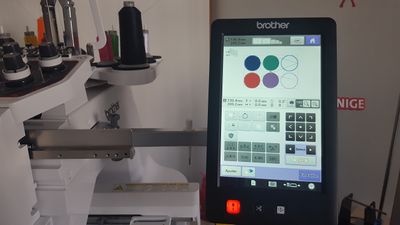 Stitch file accepted by our Brother PR1050X |
Remarks:
- Colors are wrong since the thread palette used in the viewer of Stitch Era and the embroidery machine are different from the default. Thread palettes are difficult to understand...
- There are some extra extra stitch sections that should not be stitched (the little lines).
In this section we just presented basic functionality. In particular, InkStitch allows creation of satin colums from more or less parallel lines and also simple lines.
Creating Satin Stitches
By default, Ink/Stitch translates strokes to either lines or simple perpendicular zig-zag stitches. The simple zigzag model works works relatively fine for straight lines or circles, but it cannot handle corners as in the little rocket drawing that we will now digitized. In addition, ZigZag stitches do not look as nice as the more parallel satin stitches.
Creating satin columns requires some extra work that we shall explain now.
Example explained with a snake and an ellipsoid donut
Let's create a simple snake:
(1) Draw two lines with the bezier tool.
- For starters you can just do this by clicking using the Bezier drawing tool (SHIFT-F6)
- Draw both in the same direction
We got something like this:
For exercising, you can download the original SVG (click on the picture until you get the SVG, then save as.
(2) Make sure that each path has the same number of points. If not:
- Click on the Edit Path tool (drawing tools panel next to the selection tool) or hit
F2 - Select two nodes, then click on "Insert New Nodes into selected segments" to add a new node
(3) Combine these into a single path:
- Select both lines
- Menu Path -> Combine or CTRL-K
SVG file for download (click on the picture until you see the *.svg, then "save page as":
Ellipse example
The two lines of the path do not need to be open. E.g. two embedded ellipses with the same amount of points for each line also works.
Rocket example
Let's compare a rocket stitched quickly with one that uses proper satin stitches. We will start from a little [Rocket Ship from OpenClipArt. There are several other variants of this, e.g. rocket icon by pitr that we used here.
Cleaning the SVG file
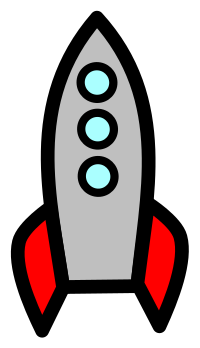 Source: [1] needing cleanup Rocket Ship as Clip Art] (SVG file) |
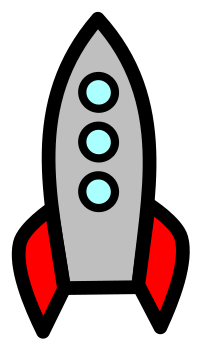 Source: Rocket Ship as Clip Art, but cleaned up |
The drawing is fairly straight forward. In order to process this with Ink/Stick
- Ungroup everything
- Create a new layer, called Rocket strokes
- Put all elements in this layer.
- Open the XML Editor, click on each element and kill about 6 useless elements that sit underneath the windows. The resulting SVG only should have six objects.
- The wings overlap with the body of the rocket, but let's keep this for the moment.
It now (at least for the 1.7x version we discuss here) is important to follow all the steps on the SVG before you configure the embroidery params. Else you may have contradictory instructions in your objects. If the embroidery process fails with an error message, try removing all embroidery parameters in the XML Editor. Create a copy of you SVG file and save it. Personally, I just "write the file as" before each major operation. This way, I can easily restart from a prior version .....
Now you could digitized as shown above. However if you want nice satin stitches then you should remove all the fills and transform the fat strokes into double lines.
Let's separate fills and strokes first. We will do this in the following way:
- Select all
- Copy and paste in place. Edit->Copy then Menu Edit-Paste in Place. We now have 12 objects instead of 6.
- Move all the new objects to a new layer called Rocket fills (select these six in the Objects tool (Menu Object->Objects), then use the layers menu to move them)
- Lock the layer called Rocket fills.
- Remove all fills from the objects that sit in Layer Rocket strokes
- Now lock this Rocket strokes layer and kill the strokes from the objects that sit in the Rocket fills layer.
The resulting object structure should look like this:
This now can be directly stitched as shown in the picture above. However, you can notice the rather ugly satin stitches.
Creating satin stitches with hand drawings
As you should recall from the "snake" example above, satin stitches are made from two lines that have the same amount of points. There are several ways to achieve this from an existing drawing. In any of these cases, you will have to do some "point surgery". Also, the result can fail. If you do not feel comfortable with using or learning more advanced path editing, you could just make some hand drawings. We suggest the following procedure:
- Lock the fills layer but keep it visible
- Create a new layer
- Draw the lines as explained in the "snake example above". Use (at least provisionally) a different color to the drawings.
The result looks OK, but I didn't take time to make minor adjustments since I spent too much time on the attempt described below).
Transforming strokes into "satin path"
Now let us go through the more complicated procedure of transforming existing graphic elements (SVG path) into path that can be stitched as satin path. Remember:
- A path must have two subpath, each with the same number of nodes that should be roughly aligned
- Each subpath must go into the same direction (see explanations later)
- Closed shapes must be broken, since InkScape does not allow to define a start node.
See also this video: https://inkstitch.org/tutorials/lex-neva-video-tutorial-1/
Before you start
- Hide the "Fills" layer and maybe lock it. I.e. you only should see the strokes !
- Unlock the "Strokes" layer if it was locked
Simplify the drawing and reduce overlaps
- Simplify the drawing, i.e. remove all extra points that are not needed (but you can do this later). InkScape can help with that (hit CTRL-L, but not too many times!)
In order to get two strokes (lines) instead of a single fat stroke, we can translate a path to a path with both fill and strokes. An other alternative would be to use insets and outsets. Anyhow:
- Select all strokes: CTRL-A (the fills should be hidden)
- Menu Path -> Stroke to Path
- Remove the fill and make the strokes smaller.
In a next step, we will have to clip the part of the wings that overlap with the body of the fuse. An easy way to do it is to use substraction again.
- Copy/paste in place the rocket body. The easiest way to do so is the open the "Objects panel" (Menu Object->Objects), select the body and the duplicate.
- Select the left wing and then the body (hold down the SHIFT key).
- Menu
- Repeat that operation for the right wing, i.e. firstly duplicated the body then subtract it.
Now make the strokes very small and remove the fill.
- Select all (CTRL-A)
- Menu Object -> Fill and Stroke
- Remove fills
- Set Stroke to 1px
Repair the wings
- Unfortunately the wings did not fully overlap with the body, and there is some junk to remove. You must strive the obtain two single lines for each wing as shown in the picture below.
- Drag out both wings.
- Select the Edit path tool
- Kill superfluous nodes
- Kill segments at the end of both wings
- (Maybe) transform the sharp corners into a round symmetric node.
Clean up the rocket body
- Now make sure that you got the same amount of nodes in the outer and the inner line. To do so, we suggest rather killing nodes than adding new nodes. When you try to embroidery a path that has two subpath of different node length, InkStitch will complain and tell you which node to fix. Remember that for later.
- Align outer and inner nodes (roughly)
- Also make sure that no node sits on top of another one. You can find out by moving each node and then - if OK - put it back in position by hitting CTRL-Z
- Make the inner top a bit less sharp (make it a symmetrical node)
If you try to embroider now, you will get a very bad results, since inner and outer path go into an opposite direction.
Fix path directions
Problem: For InkStitch to work correctly, the two sub-path must point in the same direction. In our case they were not.
- To see directions, set
Show path direction direction on outlinein Edit -> Preferences -> Tools -> Node - Reverse for example the following the outer line:
Menu: Path -> Reverse
In our example, each path had a wrong subpath, e.g. the inner path went clockwise and the outer path counter-clock wise.
Fix the start point
Problem: The zizag of the satin stitch does now work but it is badly oriented now.
- Closed paths do not have a start point and you cannot define one. As a result Inkstitch will associate "random" points, i.e. will start using the first node found in the path definition (we believe). To fix that, we will create a break in the closed path of the hull and the three windows.
- Use the Edit Path tool to select two nodes, one for each subpath, then break the path (see the figure below)
Let us parameterize separately the stroke and the fill layers.
- Hide and lock one layer before you work on the other.
- In the Embroidery -> Param popup, have all the path in the stroke layer use satin stitches if you did not do so already. Also, we suggest adding at least a center underlay since this will stabilize the tissue a bit.
The result looks like this::
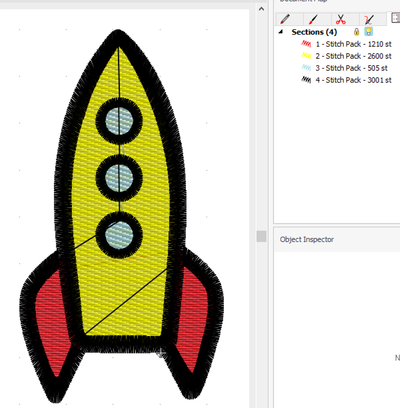 Stitch simulation (as seen in the Stitch Era software) |
Summary
Creating satin stitches from existing drawings seems to be a bit difficult. There might a way to do it more quickly, but we did not manage to find so far. So in some cases, we recommend re-drawing by hand two lines defining satin stitches. In fact all depends on your respective node editing or drawing skills. Personally I am better at editing than at drawing.
Creating fills and lines from dotted strokes does work well and doesn't require any special preparation.
Trim stitches do not seem to work in every case, but that is not a major issue. Anyhow, most people using InkStitch probably do not have multi-needle machines and prefer to cut away thread as opposed to re-threading.
Adding direction lines (rungs)
Good positioning of points on each of the two lines helps getting the stitch directions right. However, there are situations where you need to add so-called direction lines ("rungs" in InkStitch terminology) for satin columns:
- Some tricky corner areas
- Complicated drawings where moving points is both difficult and time consuming
- Special situations where you want the stitch directions to be weird.
The directions of the zigzag lines in the following example are not exactly nice.
 Round bird model (SVG File). Source Liv Iko (Noun project) |
In order to tell InkStitch how to orient satin stitches you now can add "rungs" (or direction lines) into each stitchable path. There are two methods a quick one and the one I used before I have been told about the fast one by the the creator of this program.
Quick adding of rungs
- Make sure the existing satin column path (with the two subpaths) is selected with the Node Editor tool.
- Press P or select the Pencil tool.
- Hold
Shift. - Click once at the start of the rung.
- Click a second time at the end of the rung.
Slow method for adding rungs (not holding the SHIFT key)
- Draw the direction lines for a given path using either the Bezier tool (click+click+right-click) or the freehand lines tool (click+click)
- Select the path for which we made the rungs + all the direction lines. Then hit CTRL-K (Menu: Path->Combine)
- Check if the Embroidery Parameters are still OK (Menu Extensions -> Embroidery - Params
We also fixed the departure point for the head and added an eye. The result is below and already looks much better. However, we found that the *.PES version had a mistake, so we create ad *.DST. Our Brother can stitch that too. The bug has been fixed since version 1.8.1 (see the simulation below)
If you like this bird, you can modify it. However, if you publish it, please acknowledge the original design. (Liv Iko). Also, you should be aware that this design is really small (less than 3cm), stitching it properly may be a bit difficult.
Tips
Downloading SVG files from this wiki
Most designs used in this tutorial (including the half baked and failed ones) are available as SVG files, but you will have to make a little effort to get them. Definitely, do not "save the image as". A MediaWiki (e.g. this wiki or Wikipedia) displays SVG files as reduced PNGs. In order to download the SVG:
- Click on the picture
- Click again on the picture when you see File:XXX.svg in the title. You now should just see a drawing in your browser
- Now, use the browser's file menu: Save page as or hit CTRL-S in your browser
Inkscape version
From the author of InkStitch: “I highly recommend version 0.92 or greater, which has a really key feature: the Objects panel. This gives you a heirarchical list of objects in your SVG file, listed in their stacking order. This is really important because the stacking order dictates the order that the shapes will be sewn in.
Versions 0.92.2 and higher let you bind a key to new commands, “stack up” and “stack down”, which I assign to pageup and pagedown. These let you arbitrarily reorder objects in the SVG file, which lets you directly manipulate which order they stitch in. It works way better than the default “raise” and “lower” commands.”
In older versions, e.g. Ubuntu 16LTS have 0.91X, Edit -> Preferences -> Behavior -> Selecting. Then tick "Select in all layers" but let "Ignore hidden / locked objects" ticked. This was you can translate objects that sit in different layers more easily. I also have this option for more recent versions.
Working with layers and stitch order
Objects are stitched according to foreground/background order. Last object in the list of objects in the objects panel will be stitched first since it is in the back.
You can change that order in several ways:
- In Inkscape 0.92 or higher, use the Objects panel (Menu Object -> Objects)
- Use PageUp/PageDown keys and verify in the objects panel (recommended).
- Move the position in the XML Editor
- Use layers. An Inkscape layer is just an SVG group (
g) with a special tag. So if you put an object in a layer it will have its position influenced by the layer's position.
If you import a drawing, e.g. from openclipart, you could:
- Create a new layer first (Menu: Layer -> Add Layer) or open the Layers panel (Menu: Layer -> layers)
- Select the Layer
- Copy/paste the picture from the SVG page (or import the SVG File)
- Ungroup all objects
- Maybe, arrange them in different layers according to stitch type and order
- Order (strokes and small area usually should be on top)
Printing a design
There are two options:
- Create an embroidery file, open with a free or commercial stitch file viewer, then print
- Use Menu: Extensions -> Embroidery -> Print. This functionality provides some information about the Stitch Packs, e.g. the number of stitches, color and trim/stop stitches.
Creating a patch
Creating patches is explained in the Embroidery patch article. Below is an untested example to be used preferably with the "precut" method.
Creating stitch lines
By default, InkStitch translates solid strokes bigger than 0.5pt to zigzag lines.
Since it is easier to see fatter lines, you also can make the stroke of the line dotted, i.e. not solid. It will translate to a simple stitch line as opposed to a zigzag. So, if you need a simple line, make it dotted as shown in the following picture. Bottom left shows the SVG drawing and upper right the Stitch plan.
Trouble
Error messages
error: satin column: object pathXXXX has a fill (but should not)
This probably means that you got some "left over" properties in the object that you should remove.
- Open the XML Editor
- Remove all the InkStitch properties (in particular the satin one). Click on the "remove properties" button on top
error: satin column: object path3XXX has two paths with an unequal number of points (x and y)
This means that you have extra nodes in a subpath defining a satin stitch line.
- Identify which line has an extra point, then remove it
- Click on the Edit Path by Nodes icon or hit F2
- Select the node(s) - also called points - that you want to remove.
- Kill it. This may require adjusting the Bezier controls of the adjacent points.
Notice: Points can be sneaky and hide under another one. In order to find these, you must move every node and if OK put it back in position with CTRL-Z.
error: satin column: One or more of the rungs doesn't intersect both rails.
Each rail should intersect both rungs once.
This means that your satin stitch drawings are not just made of two sub-path (lines) and/or that direction lines (rungs) are badly placed.
(.... to be completed)
Satin stitch param combination makes the script crash
As of May 2018 (InkStitch version 1.7.1 / Inkscape v. 0.91) some combinations of parameters can lead to a crash of the script, i.e. the embroidery will not be generated.
You will have to remove the InkStitch specific properties from the SVG code to fix that. This can be done for example by saving the file as simple SVG and then editing the source code. Otherwise, in InkScape, in the XML Editor (CRTL-SHIFT-X), there is a little "delete property" button on top of the property panel.
It is better to test the embroidery for each parameter change and save the file under a different version number if things go well. This way you only have to undo the last changes or copy/paste the older object that was still working.
Exemple error trace:
Traceback (most recent call last):
File "embroider.py", line 108, in <module>
File "inkscape-0.92.2/share/extensions/inkex.py", line 283, in affect
errormsg(_("No matching node for expression: %s") % path)
File "embroider.py", line 97, in effect
File "inkstitch/extensions.py", line 195, in elements_to_patches
File "inkstitch/elements/element.py", line 244, in embroider
File "inkstitch/elements/satin_column.py", line 401, in to_patches
File "inkstitch/elements/satin_column.py", line 370, in do_satin
File "inkstitch/elements/satin_column.py", line 254, in walk_paths
File "site-packages/backports/functools_lru_cache.py", line 113, in wrapper
File "inkstitch/elements/satin_column.py", line 101, in flattened_beziers
File "inkstitch/elements/satin_column.py", line 128, in flatten_beziers_with_rungs
File "site-packages/shapely/ops.py", line 464, in split
ValueError: Splitting a LineString with a GeometryCollection is not supported
[9557] Failed to execute script embroider
Birds example
Let's create an embroidery from single complex SVG paths as they can be found on the noun project. This website has a huge amount of SVB icon collections that can be combined into nice embroidery.
Get some artwork
- Get four birds from the noun project (become a member if you want to download and reuse objects without having to use them under their free CC license. I got 4 birds from the Bird collection by Liv Iko
- Pick the ones you like.
- Download as SVG !!
- If you are a non-member, remove the text with the CC license, i.e. edit each file in Inkscape, but make sure to cite the author properly if you publish your embroidery.
If you are unable to get this done, you can start from our own example, but do not publish it on any website without giving credit to Liv Iko.
Embroidery with area fills
After downloading some icons from the noun project:
- File -> Import; Select the four SVG files
After arranging the four drawings, you could see something like this:

- If you do not download from the Noun Project, you can our example above. Make sure to click twice in order to get the SVG file until you see just the drawing, then "save the page as". Also, do not forget to credit the original author.
- Save the file, e.g. call it birds0.svg
Arrange position and size
- Arrange the designs, e.g., on a bottom line and also adjust the size so that the embroidery will fit into you hoop.
- Each of the birds is now a single SVG path. These are not yet suitable for a nice colorful embroidery. We will have to break them apart
- Save the file, e.g. call it birds1.svg
- Again, you could directly take the SVG file directly from this wiki.
Break path apart
- Select all
- Menu: Path -> Break Apart
You now should see four piles of black objects.

Again, you could download the SVG source
Colorize
The result are layered "path" objects composed of fills that you now should color a bit. For each object, including the large black backgrounds:
- Add a fill color
- Remove the stroke color
- The easiest way of doing this is to open the "Fill and Strokes" panel, then the XML Editor (Shift+Control+X)
- click on each path object of the XML editor and then define a fill color and remove the stroke color if there is one.
Simplify
Currently we have up to three layers, which is too much for stitching.
- We now use the difference operator to subtract an element from the element underneath.
- Copy a smaller area that sits on top of a larger area and move it outside the graphic
- Shift-select the larger (black) area and shift-select the area that sits on top
- Menu: Path->Difference or hit CTRL+-
- Now you should see a hole in the bigger black area. Move the the save smaller area in place. Increase its size a bit so that it overlaps.
You also may want to cleanup a bit. In Inkscape, click on File->Clean up document
Create two layers
This is not strictly needed, but you should take the reflex of creating layers into which you put different types of drawing objects.
- Create a new layer and call it Areas
- Select all colored areas and move into a new layer
- Rename the layer with the black "lines" in "Lines"
Parametrize
In your SVG drawings you only got so-called fills. The plugin will translate these into areas filled with linear motif. You can change the angle and the Stitch length for now.
- Hide the Layer called Lines
- Open Extensions->Embroidery->Params. This will now allow to parametrize the Stitch Areas
- Add STOP and TRIM if you got a multi-needle machine
- Augment stitch density a bit (e.g. 0.2mm per line / 5 lines per mm)
- Change other default values or just Apply and Quit (we did not change anything else here)
- Do the same for the Lines layer, show it and hide the Area layer
Create the embroidery
- Firstly verify that you do not use too many different colors (e.g. make sure that all the orange is the same)
- Put all the same colors next to each other if you have single thread machine (use the Objects tool for that)
- Stitch the larger objects first, i.e. move them down in the layer.
- Move the "lines" layer up. Lines usually are stitched last.
- Show all layers you plan to embroider, e.g. here we got "Lines" and "Areas"
- Menu extensions -> embroidery -> embroider
- Select the machine format. As of May 2018, the PES file was incorrect, we did use DST format which Brother also can stitch. In version 1.8.1 (May 28) this has been fixed.
The simulated result now looks like this (DST gets the colors wrong, but that's not a real issue since most people do not have a sixteen needle machine with the good threads already installed).
As you can see there are also some extra objects that should not be stitched, but they won't hurt. The lines can be easily removed.
Stitched result
The stitched result is not fully optional and for two reasons
- The black borders are made with fill stitches (as opposed to satin stitches). We also should have used an underlay.
- We did use neither pull compensation nor overlap
- The tension on the black thread wasn't optimal or the is some dirt somewhere in the path or the needle needs to be replaced or cleaned ...
The second version (PES) uses and underlay for the fills.
Create borders with satin stitches
In order to get satin stitches we need to replace fat strokes by two lines. In principle the following should work, see the Rocket example above.
- Go back to an early version of the SVG file (after breaking apart)
- Select the object for which you need satin borders
- Make two copies
- Create an inset and outset: Menu Path -> Inset and Menu Path -> Outset
- Make the stroke smaller
- Remove the fill
- Make sure that each of the two object has the same number of points, remove the superfluous ones.
- Fix direction lines
- etc.
Since this is design is not too original, we only did this with the first bird. The example is described in Adding direction lines. Feel free to improve your InkScape node editing skills by completing the other birds ....
Creating an embroidery file from hand drawings
Creating embroidery files from photos, paintings or hand drawings can be very difficult and time consuming. In this place we will explain how to create stitch files from Simple drawings. This method has been tested for hundreds of drawings made for patches, e.g. at the fr:Broderie_machine_au_salon_du_livre_2018#Bilan_du_salon_du_Livre Salon du livre 2018.
Create a drawing
- use large felt pens
- use few colors
- use contrasted colors (e.g. red, blue, green, black)
- do not produce large fills (that is more related to the issue of creating something that is easier to stitch)
To the right is an acceptable example (I am not talking about the quality of the drawing).
Scan, crop and reduce colors
Many software allows reducing colors. We explain how to use Gimp, a powerful free image manipulation software. It's a complex tool that requires time-to-learn. However, the manipulations we demonstrate below, are not too difficult.
Step 1
- Scan the picture in *.jpg format
Step 2 - Crop
Crop the picture. You do not need to pay a lot of attention to the size of the margins, e.g. however you must decide whether you want the whole picture or just part of it. Below we decided to crop some of the drawing to make it more rectangular.
- Open the picture in Gimp
- Drag the mouse to select a rectangle. By default, the rectangle selection tool is already selected. You can pull/push borders of the rectangle (move the cursor real close), before you click on "Crop to Selection"
- Save the file
Step 3 - Reduce colors
As explained in the manual, color reduction is really simple (unless you require smooth transitions between colors, which embroidery does not)
Open the color reduction tool and reduce the colors with the following conversion parameters:
- Set
Maximum number of colorsto the number you can count in your drawing, plus one for the background - Do not use any dithering options.
- Click on
Convertand check the result (see after the figure)
If you can see all your drawings in the approximately right colors, then move on, else:
- Undo (hit Ctrl-Z)
- Add an extra color
- Repeat this, until you see all your drawings in a different color.
Step 4 - Adjust colors (optional)
Open the colormap:
Windows -> Dockable dialogs -> Colormap
You now could change the colors or also merge two colors, e.g. by assigning the same color code to two or more indexed colors.
You also can make the background color transparent (unless some of the drawing uses the same color.
- Add a channel for the alpha layer:
Layer -> Transparency -> Add Alpha Channel colors -> Colors to Alpha ...
Save the file.
Step 5 - Export
- Export the file to a PNG file (keep the alpha channel)
Trace the raster file with InkScape
Now you have to translate the color-reduced raster file to vector graphics. If your drawing is simple, this is not too complicated. If not, it can take hours ...
To vectorize a raster image - i.e. translate "dots" to drawings - do the following. However, depending on your drawing you may have to adopt options a bit.
- Open the picture in InkScape, i.e. import the reduced color *.png picture you created with GIMP.
- Select the picture (click on it)
- Open the tracing tool (Menu path -> Trace Bitmap)
- Tick
colorsunder Multiple scans .... - Set smooting options
- Select the number of path you want (normally the number of colors you got). If add more, e.g. 8 for 4 colors, it will produce traces for the strokes for example. Start with N = you colors + the background, then click on Update. If the preview is OK, then trace.
- Click OK
Normally, for embroidery, use agressive smoothing options (however, this doesn't have an interesting effect in our case.):
After tracing, the picture is still there, you can consider killing or leaving it as hidden layer. Now check the result
- Hide the picture layer
- Open the path layer
- For each path give it meaningful name, e.g. the color.
As you can see, despite aggressive smoothing options, the tracing procedure did not really smooth. To smooth the path, you now can use the normal smoothing tool
- If you feel lucky: Select All (CTRL-A)
- CTRL-L or Path->Simplify
Now save the file as *.svg
Prepare for embroidery
If not already done so, adjust the size of your embroidery.
- Set the measures from px to mm or whatever you like
- Lock dimensions
- Type the new size
Create a layer for the embroidery (optional)
- Create a new layer
- Move all the objects you want to stitch in there (using the Menu: Layers -> Move Selection to Layer)
Create single polygones:
- Since InkStitch wants to have connected path, you may have to break apart paths that are not, e.g. the blue one in our case. Also the green did have on little extra speckle somewhere.
- Menu
Path -> Break Apart(CTRL-SHIFT-K)
Now, most of this design should be embroidered with sating stitches. There are two ways of doing this:
- Modify the path as described before
- Add extra scans to the tracing (e.g. 8 instead of 4)
In both cases, there will be some work. Use direction lines (rungs) to segment path.
Links
- Ink/Stitch (home page, which includes several manual pages)
- Ink/Stitch Github directory
- Inkstitch Intro Video (Youtube)
Copyright modification
Contents of this page including pictures and SVG files are also available under the GNU Free Documentation License and the Attribution 4.0 International (CC BY 4.0) license.
The Inkstitch project can use any element (text fragments, SVG files, pictures) for the project's official docs without giving attribution (just copy and paste).
